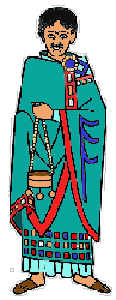Byzantine Clothing

The essential articles of Byzantine dress are simple and easy to construct. The primary article of dress was called a tunica. The tunica served as the basic undergarment of both men and women, or the only garment for the working class and poor.
The main over-garment worn both by men and women is called the dalmatica. This garment began a t-tunic, but became more tailored in eighth century. The essential line of a dalmatica is triangular, with narrowing sleeves or flaring sleeves.
Another over-garment for women only is the stola. The stola is unchanged from Roman times. Prior to seventh century the stola was the only over-garment for women. In seventh and eight centuries the stola developed bell-shaped sleeves and became undistinguishable from the dalmatica. Outer wear consisted of three different style cloaks, the paludamentum in semi-circle or trapazoid shapes and the paenula, a full circle cloak.
The Byzantines were very fond of vibrant, bright colors, reserving royal purple for the emperor and empress. Their dress is richly ornamented with embroidery and trim. The highest classes ornamented with jewels, particularly pearls. Fabrics consisted of linen for tunicas and some dalmaticas, stolas, and cloaks; Silk for richer tunicas, dalmaticas, stolas and cloaks. Dalmaticas and cloaks were of wool as well. Egyptian cotton was found in tunicas, though very rarely.
Very little is known of Byzantine footwear, no examples have survived, and images show little. Royal footwear does show jewels and embroidery. Accessories to wealthier Byzantine dress include: Sudarium, an elaborate embroidered handkerchief; contabulatim, a long embroidered cloth, sometimes fan-folded and wound around the body; pallium, a very rich, hem length, jeweled court tabard, worn by men; and the superhumeral, an elaborate embroidered and sometime jeweled collar. When extensions wear added to the superhumeral, it became a pallium.

The essential articles of Byzantine dress are simple and easy to construct. The primary article of dress was called a tunica. The tunica served as the basic undergarment of both men and women, or the only garment for the working class and poor.
The main over-garment worn both by men and women is called the dalmatica. This garment began a t-tunic, but became more tailored in eighth century. The essential line of a dalmatica is triangular, with narrowing sleeves or flaring sleeves.
Another over-garment for women only is the stola. The stola is unchanged from Roman times. Prior to seventh century the stola was the only over-garment for women. In seventh and eight centuries the stola developed bell-shaped sleeves and became undistinguishable from the dalmatica. Outer wear consisted of three different style cloaks, the paludamentum in semi-circle or trapazoid shapes and the paenula, a full circle cloak.
The Byzantines were very fond of vibrant, bright colors, reserving royal purple for the emperor and empress. Their dress is richly ornamented with embroidery and trim. The highest classes ornamented with jewels, particularly pearls. Fabrics consisted of linen for tunicas and some dalmaticas, stolas, and cloaks; Silk for richer tunicas, dalmaticas, stolas and cloaks. Dalmaticas and cloaks were of wool as well. Egyptian cotton was found in tunicas, though very rarely.
Very little is known of Byzantine footwear, no examples have survived, and images show little. Royal footwear does show jewels and embroidery. Accessories to wealthier Byzantine dress include: Sudarium, an elaborate embroidered handkerchief; contabulatim, a long embroidered cloth, sometimes fan-folded and wound around the body; pallium, a very rich, hem length, jeweled court tabard, worn by men; and the superhumeral, an elaborate embroidered and sometime jeweled collar. When extensions wear added to the superhumeral, it became a pallium.

تعليق